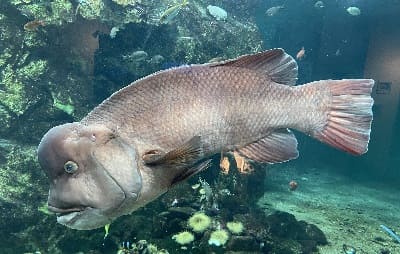Home › Sea Life › Marine Creatures › Vertebrates › Wrasse › Asian Sheepshead
Facts about the Asian Sheepshead Wrasse
[Phylum: Chordata] [Class: Actinopterygii] [Order: Labriformes (ray-finned)] [Genus: Semicossyphus]
Despite being a delicacy throughout much of Asia, adult Kobudai (Semicossyphus reticulatus) can live for 20 years and grow to a length of 100 centimetres.
This guide contains interesting facts and information about Asian sheepshead wrasse, including where the Labridae family live, what they eat, and how they reproduce.
Distribution of Asian Sheepshead Wrasses
Also known as Kobudai in Japan, the Semicossyphus reticulatus is one of the largest of all wrasse species.
You can find them in the open sea, subtidal beds of the western Pacific Ocean, especially around the rocky reefs and wrecks in:
- The Korean Peninsula
- China
- Japan
- The Ogasawara Islands
In general, Asian sheepsheads are a reclusive, solitary species. But, this behavioural pattern of 'isolation' changes to one of 'coupling' throughout the breeding season (see below).
Asian Sheepshead Characteristics
Very few vertebrate fish species display the pinkish-grey colouring of these giant wrasses. In addition, two sizable protrusions on the chin and forehead are unique features to these creatures.
The California sheephead (Semicossyphus pulcher) is a close relative and they both share several other traits. For example, there are noticeable and blunt differences, in appearance and behaviour, between the juveniles and the adults.
Here's the thing:
The young have a yellowish or orange body colouring. They also have a white stripe running from the lower part of the eye to the middle of the tail.
You'll also see black patches on the tail and fins. But, the most striking feature of juvenile sheepsheads is the 'lack' of any bulbous face protrusions.
As the strongest and biggest specimens grow, the skin colour changes and they sprout their distinctive hump. The females usually start the one month-long transformation to become males around the age of ten (10).
In fact, male Asian sheepshead wrasses can grow to one metre long (3 feet) when they fully mature. It's common for this fish to weigh in excess of thirteen (13) kilograms (30 pounds).
Pro Tip: Click through to our section that lists funny common names for fish species with explanations behind the titles, such as Bombay duck and the slippery dick wrasse.
What Do Asian Sheepshead Eat?
Being a typical omnivore means this species will generally feed on a combination of meat and plant-based foods, especially:
 Aquatic crustaceans
Aquatic crustaceans- Blue crab
- Chironomid midges
- Clams
- Oysters
- Polychaetes (annelid worms)
- Shellfish
- Small juvenile fish (e.g. Atlantic croaker)
- Zooplankton
Sheepshead Wrasse Reproduction
The formation of a male and female pair needs to occur before the spawning process can go ahead. This is when scuba divers will see Asian sheepshead wrasse swimming in pairs (or sometimes groups of pairs).
Even though they are oviparous fish, they are also protogynous and sequential hermaphrodites. Thus, all wrasses will be born as a female and some will change their gender to become a male to start the breeding process.
But wait - there's more:
They spend a lot of time around rocky coral reefs during the gestation period. Even though gestation may last for eleven months, this is where they will eventually release the fertilised eggs. In most cases, the eggs will hatch 5 days after spawning.
Threats and Predators
Accurate information about the population status of the Asian sheepshead wrasse is limited. Nonetheless, it is fair to describe it as being 'vulnerable' due to human eating habits and overfishing.
Plus, there is always a bigger risk for sex-changing fish. Fishers tend to target the largest fish (usually the males), which can lead to an imbalance in female-biased ratios.
Pro Tip: There is some protection for spawning adult species of wrasses from local divers in selected regions of the Japan Sea.
Related Information and Help Guides
- Wrasses Facts and Species Information with Video
- Slingjaw Wrasse: Everything You Need to Know.
- Slippery Dick Wrasse Fun Facts and Information
- Flashlight Fish Facts and Information with Pictures
- List of Marine Vertebrates Examples for Beginners
Note: The short video contains some interesting footage about a unique relationship between a Japanese diver and Yoriko, a friendly Asian sheepshead wrasse (Semicossyphus reticulatus).